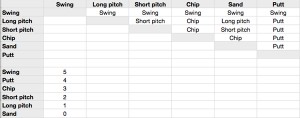I’ve been spending my time around the practice green lately. Here are a few things I reminded myself of.
1. Slow down your swing. This advice is generally stated in the context of the golf swing, but it applies with equal force to short shots. Poor contact on chip shots is too often caused (in my game) by making the stroke too brisk. Slow it down. Try practicing a few chips with a stroke that takes as long to make as your full swing does.
2. Chipping is pretty complicated. To get good at it, give yourself as many different shots as possible and figure out which club and stroke gives you the best results. (See #5, below.)
At the most basic, you can vary the distance from ball to green and green to hole. Mix and match long and short distances for both. You might be forced to hit over an obstacle. You can chip into a downhill slope or an uphill slope. You can have a cushy lie, a tight lie, or be in the rough. You can chip to a green that is elevated (common) or a green that is lower than the level of your ball.Watch Full Movie Online Streaming Online and Download
3. From outside 10 feet, all that matters is speed. You can read the line well enough to get the ball close, but more important is to get the ball cozying up to the hole speedwise. That’s how those 20-footers fall in.
4. When you address a putt, let the sole of the putter rest very lightly on the top of the grass. That way you can start the club back smoothly. If the putter rests with its weight on the ground, you have to subtly lift up the putter, then swing it back. That is enough to disrupt your stroke.
5. I now use one club for chipping – my 48-degree pitching wedge. Elsewhere on this blog I talk about using one swing with six clubs for calibrated distances. That works well, but using one club makes you learn how to hit shots, improving your overall skill as a golfer.

